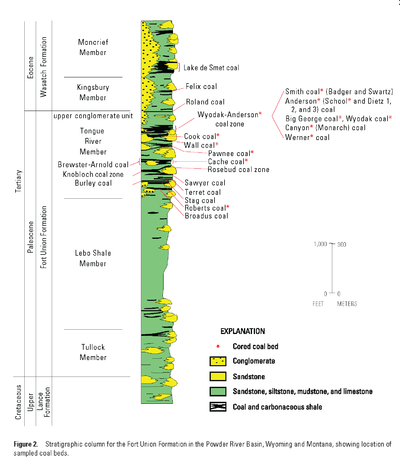Fort Union Formation
The Fort Union Formation is a geologic unit containing sandstones, shales, and coal beds in Wyoming, Montana, and parts of adjacent states. In the Powder River Basin, it contains important economic deposits of coal, uranium, and coalbed methane.[1]
| Fort Union Formation Stratigraphic range: Maastrichtian-Selandian (Lancian-Clarkforkian) ~66–58 Ma | |
|---|---|
Fossils from the Fort Union Formation | |
| Type | Geological formation |
| Sub-units | Atwell Gulch, China Butte, Ekalaka, Lebo, lower Ludlow, Overland, Rock Bench Quarry, Sentinel Butte, Shotgun, Somber beds, Tongue River, Tullock, upper Ludlow |
| Underlies | Wasatch Formation |
| Overlies | Hell Creek Formation, Lance Formation |
| Lithology | |
| Primary | Sandstone, shale |
| Other | Coal |
| Location | |
| Region | Montana, North Dakota Wyoming, Colorado |
| Country | |
| Extent | Powder River Basin |

Description
The Fort Union is mostly of Paleocene age and represents a time of extensive swamps as well as fluvial and lacustrine conditions. The rocks are more sandy in southwestern Wyoming and more coal-bearing in northeast Wyoming and southeast Montana, reflecting a general change from rivers and lakes in the west to swamps in the east, but all three environments were present at various times in most locations.[2]
Coal in the Fort Union in the Powder River Basin occurs mainly in the Tongue River Member, where as many as 32 coal seams total more than 300 feet in thickness.[1] One such bed, the Wyodak Coal near Gillette, Wyoming, is as much as 110 feet (34 m) thick. Most of the coals in the Fort Union Formation are ranked subbituminous.[3]
Fossil content
A partial ornithurine coracoid bone found in this formation is identical to others found in the older Hell Creek Formation. At present, this unnamed species is the only known individual bird species that have survived the Cretaceous–Paleogene extinction event.[4]
See also
- Uranium mining in Wyoming
- Guaduas Formation, contemporaneous coal-bearing formation of northern South America
References
- Wyodak Coal, Tongue River Member of the Fort Union Formation, Powder River Basin, Wyoming: "No-Coal Zones" and Their Effects on Coalbed Methane Production, by Mark Ashley, 2005
- Eocene and Paleocene rocks of the southern and central basins, by Robert E. McDonald, in Geologic Atlas of the Rocky Mountain Region, Rocky Mountain Association of Geologists, Denver, CO, 1972: p. 248
- Cretaceous and Tertiary coals of the Rocky Mountains and Great Plains regions, by R.M. Flores and T.A. Cross, 1991, in Economic Geology, U.S., Geological Society of America, Decade of North American Geology Series, vol. P-2, p. 547-571.
- Longrich, N.R., Tokaryk, T. and Field, D.J. (2011). "Mass extinction of birds at the Cretaceous–Paleogene (K–Pg) boundary." Proceedings of the National Academy of Sciences, 108(37): 15253-15257. doi:10.1073/pnas.1110395108